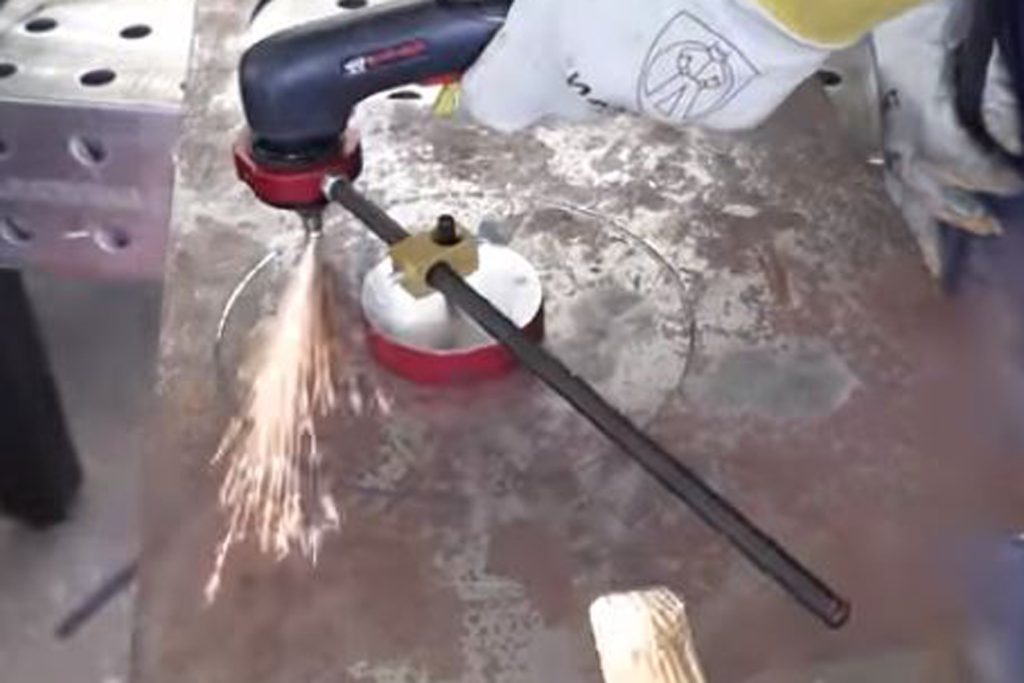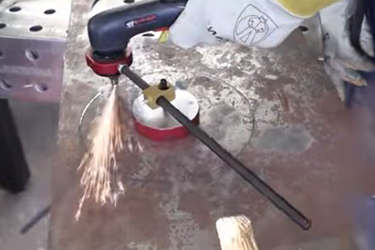Welcome to the world of plasma cutting! Whether you are a DIY enthusiast or a professional fabricator, understanding the basics of plasma cutting is essential. In this article, we will provide you with a comprehensive guide to help you get started with plasma cutting. Plasma cutting is a versatile and efficient technique for cutting through various types of metals. By using a high-intensity plasma arc, it melts the metal and blows away the melted material, creating a precise and clean cut. From creating custom metal artwork to fabricating complex metal components, plasma cutting can be a game-changer in your projects.
In this beginner’s guide, we will cover everything you need to know for plasma cutting. We’ll delve into the components and safety precautions of a plasma cutter, discuss different types of plasma cutters available in the market, and guide you through the step-by-step process of making accurate cuts. We’ll also share some tips and tricks to boost your efficiency and ensure a smooth cutting experience.

What is Plasma Cutting?
Plasma cutting is a process that involves cutting through metals using a high-temperature, high-velocity jet of ionized gas. This gas, known as plasma, is created by passing an electric arc through a gas such as nitrogen, oxygen, or argon. The plasma arc melts the metal and blows away the molten material, resulting in a precise and clean cut.
Plasma cutting is highly versatile and can be used to cut a wide range of conductive metals, including steel, stainless steel, aluminum, copper, and brass. It is commonly used in industries such as automotive, construction, manufacturing, and metal fabrication.
Plasma cutting offers several advantages over traditional cutting methods, such as sawing or shearing. It allows for faster cutting speeds, superior precision, and the ability to cut through thicker materials. Additionally, plasma cutting produces minimal heat-affected zones and leaves behind a clean, smooth edge, reducing the need for secondary finishing processes.
To perform plasma cutting, you will need a plasma cutter, which consists of several key components. Let’s take a closer look at these components and understand their functions.
Plasma Cutting Equipment and Tools
A plasma cutter is a specialized tool that utilizes the power of plasma to cut through metals. It consists of four main components: a power supply, a plasma torch, a gas console, and a CNC controller (in some advanced models). The power supply is responsible for generating the electrical energy required to produce the plasma arc. It converts the input power to a high-frequency, high-voltage current that is then transferred to the plasma torch.
The plasma torch is the handheld device that delivers the plasma arc to the metal being cut. It consists of a nozzle, an electrode, and a swirl ring. The nozzle focuses the plasma arc onto the metal, while the electrode provides the electrical conductivity. The swirl ring controls the flow of gas and helps stabilize the plasma arc. The gas console supplies the gas needed for plasma cutting. Different gases can be used depending on the type of metal being cut. For example, nitrogen is commonly used for cutting stainless steel, while oxygen is suitable for cutting mild steel. The gas console also regulates the gas flow and pressure.
In advanced plasma cutting systems, a CNC controller is used to automate the cutting process. It allows for precise control of the plasma torch movement, enabling complex shapes and designs to be cut with ease. CNC controllers are commonly used in industrial settings where high productivity and accuracy are required.
Safety Precautions for Plasma Cutting
While plasma cutting offers numerous benefits, it is important to prioritize safety when working with this powerful tool. Here are some essential safety precautions to keep in mind:
Wear protective gear
Always wear appropriate personal protective equipment (PPE) when operating a plasma cutter. This includes safety glasses, a welding helmet with a shade 8-10 filter, flame-resistant clothing, and gloves.
Ensure proper ventilation
Plasma cutting generates fumes and gases that can be harmful if inhaled. Make sure to work in a well-ventilated area or use an exhaust system to remove the fumes.
Inspect the equipment
Before each use, inspect the plasma cutter for any damaged or worn-out parts. Ensure all connections are secure and the cables are in good condition.
Keep a safe distance
Maintain a safe distance from the cutting area and other people. The plasma arc can reach temperatures of up to 30,000 degrees Fahrenheit, posing a burn hazard.
Use a grounding clamp
Always connect the workpiece to a grounding clamp to prevent electrical shock. Ensure the clamp is securely attached to the metal being cut. Familiarize yourself with the user manual: Read and understand the user manual provided by the manufacturer. It contains important information about the safe operation and maintenance of the plasma cutter.
By following these safety precautions, you can minimize the risks associated with plasma cutting and ensure a safe working environment.
Plasma Cutting Techniques and Tips
Now that you have a good understanding of the equipment and safety precautions, let’s dive into the plasma cutting process itself. Here are some techniques and tips to help you make accurate cuts and improve your efficiency:
Mark your cutting line
Before starting, mark the desired cutting line on the metal using a marker or layout fluid. This will serve as your guide throughout the cutting process.
Maintain a consistent travel speed
It is important to maintain a consistent travel speed while cutting. Moving too fast can result in a rough cut, while moving too slow can cause excessive heat buildup and warping of the metal.
Pierce the metal properly
When starting a cut, it is essential to pierce the metal properly. This can be done by positioning the plasma torch at a slight angle and applying gentle downward pressure until the arc pierces through the metal.
Use standoff guides
Standoff guides help maintain a consistent distance between the plasma torch and the metal being cut. This ensures a clean and uniform cut throughout the process.
Optimize the cutting parameters
Adjusting the cutting parameters, such as the amperage, gas flow rate, and standoff distance, can greatly affect the quality of the cut. Experiment with different settings to find the optimal parameters for your specific application.
Practice proper torch movement
Move the plasma torch in a smooth and steady motion along the cutting line. Avoid sudden starts or stops, as this can result in uneven cuts or dross buildup.
Clean the cutting surface
After each cut, clean the cutting surface to remove any slag or dross. This will help ensure the next cut is clean and precise.
By implementing these techniques and tips, you can improve your plasma cutting skills and achieve better results in your projects.
Common Applications of Plasma Cutting
Plasma cutting finds applications in various industries and can be used for a wide range of purposes. Some common applications include:
Metal fabrication
Plasma cutting is widely used in metal fabrication to create intricate shapes and designs. It is commonly used for cutting metal sheets, pipes, and structural components.
Automotive industry
Plasma cutting is utilized in the automotive industry for cutting metal parts, such as chassis, exhaust systems, and body panels.
HVAC industry
HVAC (Heating, Ventilation, and Air Conditioning) systems often require custom metal components, which can be easily fabricated using plasma cutting.
Art and sculpture
Plasma cutting allows artists and sculptors to create custom metal artwork with intricate details. It offers flexibility and precision in shaping metal.
Shipbuilding and construction
Plasma cutting is crucial in shipbuilding and construction for cutting steel plates, beams, and other structural elements.
These are just a few examples of the wide range of applications that plasma cutting can be used for. Its versatility and efficiency make it a valuable tool in various industries.
Choosing the Right Plasma Cutting Machine
When it comes to choosing a plasma cutting machine, there are several factors to consider. Here are some key considerations to help you make an informed decision:
Cutting capacity
Determine the maximum thickness of the metal you will be cutting. Choose a plasma cutter that can handle the required thickness.
Power supply
Consider the power supply available in your workspace. Ensure the plasma cutter you choose matches the power requirements.
Duty cycle
The duty cycle refers to the amount of time a plasma cutter can operate continuously without overheating. Choose a machine with a duty cycle suitable for your needs.
Portability
If you require mobility, opt for a portable plasma cutter that is lightweight and easy to transport.
Consumables availability
Check the availability and cost of consumables such as electrodes and nozzles. This will ensure you can easily replace worn-out parts when needed.
Brand reputation and warranty
Research different brands and read customer reviews to determine the reputation and reliability of the manufacturer. Choose a plasma cutter that comes with a warranty for peace of mind.
By considering these factors, you can select a plasma cutting machine that meets your specific requirements and delivers optimal performance.
Maintenance and Troubleshooting Tips for Plasma Cutting
To ensure the longevity and performance of your plasma cutting machine, regular maintenance is essential. Here are some maintenance tips to keep in mind:
- Clean the torch and consumables: Regularly clean the torch and replace worn-out consumables to maintain optimal cutting performance. Follow the manufacturer’s recommendations for cleaning intervals.
- Inspect the cables and connections: Check the cables and connections for any signs of wear or damage. Ensure all connections are tight and secure.
- Check the gas pressure and flow: Monitor the gas pressure and flow rate to ensure consistent cutting quality. Adjust if necessary.
- Keep the machine clean: Remove any dust, debris, or metal shavings from the machine to prevent interference with the cutting process.
In case you encounter any issues with your plasma cutter, here are some troubleshooting tips:
- Uneven cuts: Uneven cuts can be caused by improper torch movement or incorrect cutting parameters. Ensure you are moving the torch smoothly and experiment with different settings to achieve a clean cut.
- Excessive dross: Excessive dross, or molten metal buildup, can be caused by incorrect gas flow or standoff distance. Adjust these parameters to minimize dross formation.
- No arc or weak arc: If you are experiencing issues with the arc, check the electrode and nozzle for damage or wear. Replace them if necessary.
By performing regular maintenance and addressing any troubleshooting needs, you can keep your plasma cutting machine in optimal condition and extend its lifespan.
Conclusion
Plasma cutting is a powerful technique that offers precision, versatility, and efficiency in cutting various types of metals. Whether you’re a DIY enthusiast or a professional fabricator, understanding the basics of plasma cutting is essential. By following the guidelines and tips provided in this article, you can confidently embark on your plasma cutting journey and unlock a world of possibilities in metal fabrication.
Prioritize safety at all times and familiarize yourself with the specific features and capabilities of your plasma cutting machine. With practice and experience, you’ll be able to master this fascinating art and achieve impressive results in your projects.
